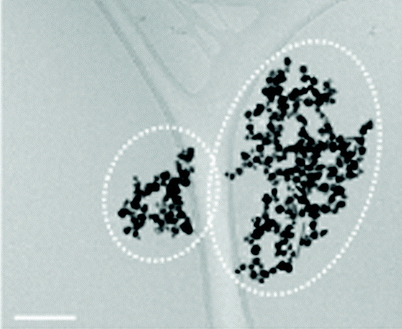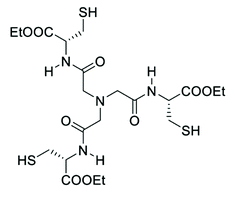Silver nanoparticles (AgNP) are efficient biocides (bactericidal and virucidal) used in consumer products and medical devices. Their activity is due to their ability to release bioavailable Ag(I) ions, making them long-acting biocides. However, AgNPs are generally released quickly from the product, which limits their action over time. In addition, AgNPs are very sensitive to various chemical environments that can lead to their transformation, thus decreasing their activity. Overall, although useful, the widespread use of AgNPs leads to bacterial resistance and health safety problems, requiring innovation towards products that are safer for humans and the environment.
IRIG researchers, supported by UGA, CEA and
LabEx SERENADE, have developed a novel concept for Safer-by-Design nanomaterials. It consists of assembling silver nanoparticles together thanks to a bio-inspired molecule (
Figure) that binds covalently to the surface of the nanoparticles through its three thiol functions. The result is a nanomaterial that can release Ag(I) ions in a slow and controlled manner, unlike AgNPs currently used as biocides, which undergo uncontrolled processes of transformation and product release. The AgNP assemblies that have been developed allow for the establishment of scaffolding that protects nanoparticles from massive transformations induced by various environmental conditions. Moreover, these architectures do not prevent the release of Ag(I) but only slow it down, providing a nanomaterial that can be considered as a promising new safer biocide.

| |

|
| | |
AgNP assemblies visualized by cryo electron microscopy. | | Structure of the bioinspired tripodale L3S molecule. |
The biological activity of assemblies of different diameters was compared to that of the original AgNPs to better understand their potential as biocides and their toxicity for humans. The results show that all assemblies have anti-bacterial activity against gram-negative as well as gram-positive bacteria. This last point is particularly interesting because AgNPs are generally not active against this type of bacteria, in particular because of their ability to modify the surface of nanoparticles. In addition, no toxicity of AgNP assemblies was observed when a human hepatocarcinoma cell line was exposed to them. AgNP assemblies therefore possess broad-spectrum biocidal activity, and their cytotoxicity to eukaryotic cells is significantly lower than that of AgNP alone.
Thus, assemblies of silver nanoparticles can be considered as the basic elements of future biocides designed with health safety in mind. The release of Ag(I) ions from these assemblies can be adjusted and their low sensitivity to the surrounding environment make it a long-lasting biocide whose risks for humans and the environment are considerably reduced compared to the technologies currently in use.
LabEx SERENADE stands for Laboratory of Excellence for Safe(r) Ecodesign Research and Education applied to NAnomaterial DEvelopment and it is a Safe by Design project. SERENADE is a partnership between french and foreign academic institutions and also industrial companies.